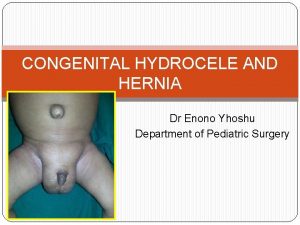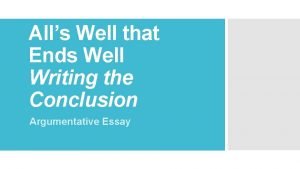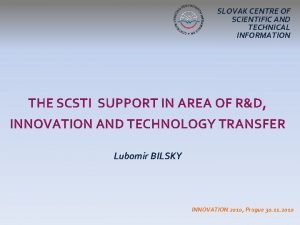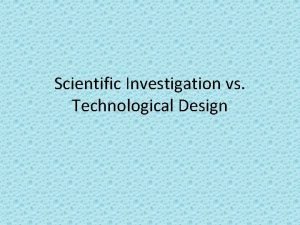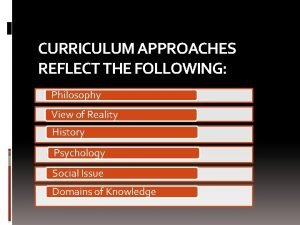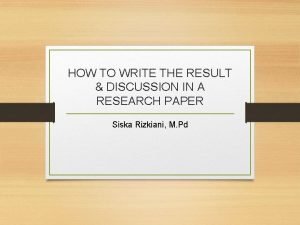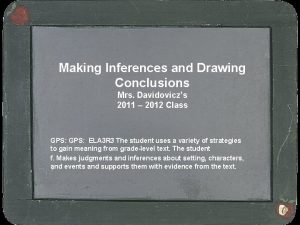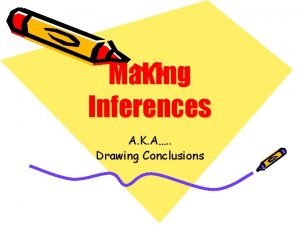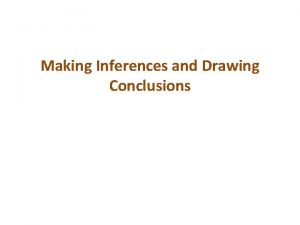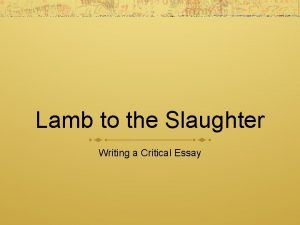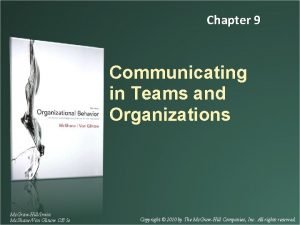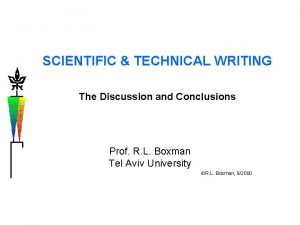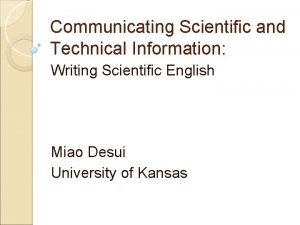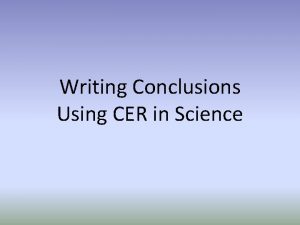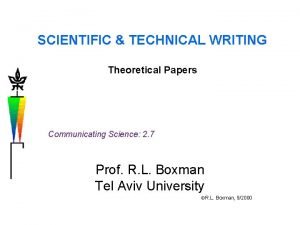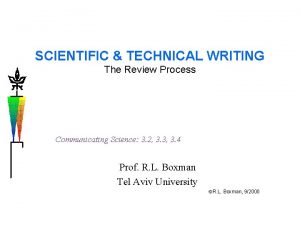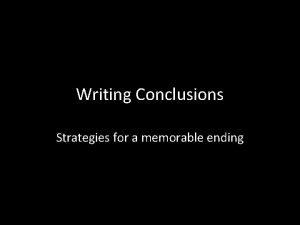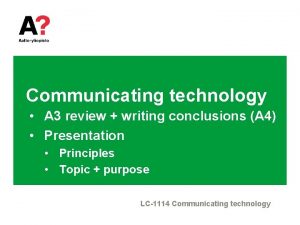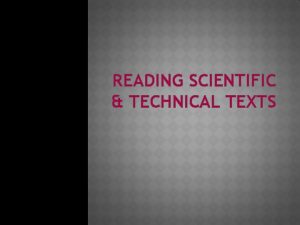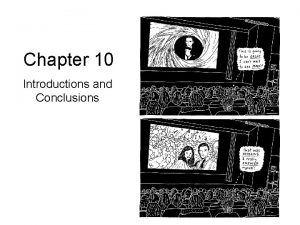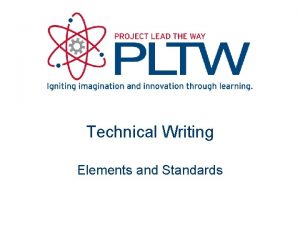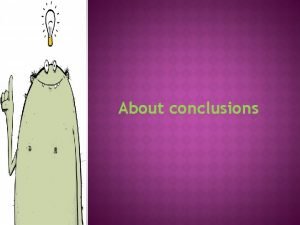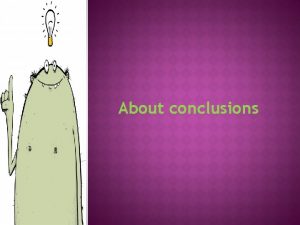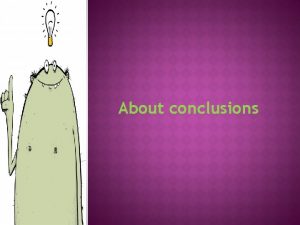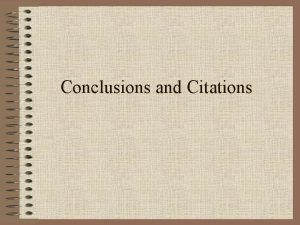SCIENTIFIC TECHNICAL WRITING The Discussion and Conclusions Communicating





















- Slides: 21

SCIENTIFIC & TECHNICAL WRITING The Discussion and Conclusions Communicating Science: 2. 8, 2. 9 Prof. R. L. Boxman Tel Aviv University R. L. Boxman, 9/2000

Trapezoidal Organization Introduction Experimental Details Broad background Narrow focus Results Discussion Broad implications TEL AVIV UNIVERSITY 2

The Discussion • Puts the results in their proper scientific context • Answers the question “So what? ” • Explains the significance of the results • Converts “information” into “knowledge” Discussion Technical Writing in English 3

Discussion Elements Reminders 1. Reference to main (narrow focus) objective, hypothesis, or research question. 2. Review of the most important findings. Interpretations 3. Justifications (broaden focus) 4. Limitations 5. Comparisons 6. Validations 7. Explanations Implications 8. Generalizations (further broaden 9. Significance focus) 10. Recommendations Discussion Technical Writing in English 4

Typical Discussion Elements • Specific reference to the present study: 1. Reference to main purpose or hypothesis 2. Review of the most important findings 3. Limitations and justifications: * Demonstration of self-consistency (e. g. , with model assumptions) * Demonstration of statistical validity * Limitations of technique and their implications (e. g. , bandwidth of instrument high frequency components, if existent, cannot be observed) Discussion Technical Writing in English 5

Typical Discussion Elements continued Specific reference to the present study (continued) 4. Comparisons * Between different elements of the present study * With previous works (between various theories, between various experiments, between experiment and theory, or theory and experiment) Discussion Technical Writing in English 6

Typical Discussion Elements continued • General statements 5. Implications and generalizations 6. Recommendations * For future research * Practical applications • Discussion starts with specific statements re. present study, and diverges towards more general statements Discussion Technical Writing in English 7

Author’s attitude Sliding scale of certainty for explanations and implications: category use key words example speculation idea or ideas that come to mind may, possible, “A possible explanation is that the specimen may be heated by the process. ” conceivably likely Discussion some evidence supports this idea suggests, indicates Technical Writing in English “The increased electrical conductivity suggests that the sample is heated by the process. ” 8

Sliding scale of certainty very likely substantial evidence supports this idea is consistent, strongly suggest “The increased electrical conductivity as well as the increased radiance, strongly indicate that the sample is heated by the process. ” most likely There is more evidence and/or theoretical support for this idea than any other existing idea most likely proven All possible explanations are on the table, and a decisive test indicates that this idea and only this idea explains the observation proven, proves, proof, shown, demonstrated “The most likely explanation for the increased electron emission is sample heating by the process. ” “Thus it was proven that the increased electron emission is caused by process sample heating. ” Discussion Technical Writing in English 9

Complex Structure in Discussion Statements Main Clause THAT Noun Clause (researcher’s position) (information) Thus it was proven that the increased electron emission is caused by process sample heating. Discussion Technical Writing in English 10

Verb Tense • Simple Past – common in specific references to current study sentence type Example Refer to purpose “The objective of the present study was to correlate systolic anomalies with genetic factors. ” “It was initially expected that instabilities would be observed above a threshold voltage. ” “However, constant output was observed for the entire range of parameters investigated. ” Refer to hypothesis Refer to findings Discussion Technical Writing in English 11

Verb Tense - explanations and limitations condition tense example generally applicable present “Increased nitrogen incorporation produces harder coatings. ” restricted to this study past “The increased coating hardness was the result of increased nitrogen incorporation. ” speculative modal auxil. “The increased coating hardness may have been the result of increased nitrogen incorporation. ” Discussion Technical Writing in English 12

Verb Tense continued • Comparisons – use the present tense. – Example: “The present results disagree with Smith’s earlier findings [23]. ” • General statements (explanations, implications) – present, modal auxiliaries, tentative verbs. – Examples: • The present results demonstrate the necessity of controlling the axial magnetic field. • The increased throughput observed here may be caused by the more efficient packing and unpacking operations. • It is likely that further improvements can be obtained by placing acoustic absorbers on the partitions between firing positions, as well as on the ceiling and floors. Discussion Technical Writing in English 13

No New Results in Discussion! • Don’t introduce “new” results in the Discussion !!! – The discussion should discuss results • Presented earlier in the paper, or • In the literature (with a specific reference). – Don’t put forward “new” facts in the discussion!!! • Don’t “pull rabbits out of the hat”. Discussion Technical Writing in English 14

Conclusions • May be the concluding paragraph of the discussion, or • A separate section, entitled “Conclusions”, or “Conclusions and Recommendations” • Should be very short (1 -2 paragraphs in a paper, 0. 5 -2 pages in a thesis. Discussion Technical Writing in English 15

Conclusions continued • Should be self-contained – No references • either internal (e. g. see Fig. 3) • or external (e. g. …Smith [3]) • Recommendations or suggestions for further work – Must be firmly based on the present work. Discussion Technical Writing in English 16

Conclusions – “do’s” • Summarize the most important results, and their implications. – Remember - this is a summary. – The implications should have been developed and discussed in the Discussion. • Think in terms of 3 things you want the reader to remember. • The conclusions should contain the answer to the “research question” – Or an “admission of failure”, (in which case perhaps the paper should be rewritten around a more modest research question). Discussion Technical Writing in English 17

Conclusions – “don’ts” • Don’t repeat objectives or methodology. • Don’t use indicative sentences. – Example: “The acoustic pressure generated by firing various weapons was measured. ” • No “new” information – this section should summarize results and ideas which are presented and developed in detail in previous sections (i. e. results and discussion). Discussion Technical Writing in English 18

Compatibility of the Research Question, Gap Statement, Objectives and Conclusions • RQ, gap, objective, value statement (when included) and answer to the RQ (in Conclusions) must be mutually compatible. • Research Question (RQ) is the research objective expressed as a one sentence question. – Demands an answer, – Must be a grammatical question, ending with "? " TEL AVIV UNIVERSITY 19

Compatibility of RQ, Gap, Objectives and Conclusions (Continued) • The Gap Statement explicitly states what was not done previously or what was wrong in previous work, using a negative word (not, never, etc. ) • The Objective states the purpose of the work – Answer the research question – Fill the gap TEL AVIV UNIVERSITY 20

Compatibility of RQ, Gap, Objectives and Conclusions (Continued) • The optional value statement is an outgrowth of all of these elements. – Describes the potential benefit of research – Answers “so what? ” • Conclusions must explicitly and informatively – Answer the RQ – Fill in the gap. TEL AVIV UNIVERSITY 21
 What is technical/academic writing
What is technical/academic writing Persistent processus vaginalis
Persistent processus vaginalis How to write a conclusio
How to write a conclusio Informational writing conclusion
Informational writing conclusion Fractional distillation introduction
Fractional distillation introduction Slovak centre of scientific and technical information
Slovak centre of scientific and technical information Ib global contexts
Ib global contexts Scientific vs technical
Scientific vs technical Intellectual-academic approach
Intellectual-academic approach What to write in results and discussion
What to write in results and discussion Scientific inquiry vs scientific method
Scientific inquiry vs scientific method How is a scientific law different from a scientific theory?
How is a scientific law different from a scientific theory? Drawing conclusions and making inferences powerpoint
Drawing conclusions and making inferences powerpoint Example of drawing inferences
Example of drawing inferences What conclusion can you draw out form the pie graph
What conclusion can you draw out form the pie graph Inferences and conclusions practice
Inferences and conclusions practice How to make a generalization
How to make a generalization When drawing conclusions, make sure you
When drawing conclusions, make sure you Argument of definition
Argument of definition Example of conclusion and recommendation in report
Example of conclusion and recommendation in report Make inferences and draw conclusions
Make inferences and draw conclusions Persuasive communication
Persuasive communication

